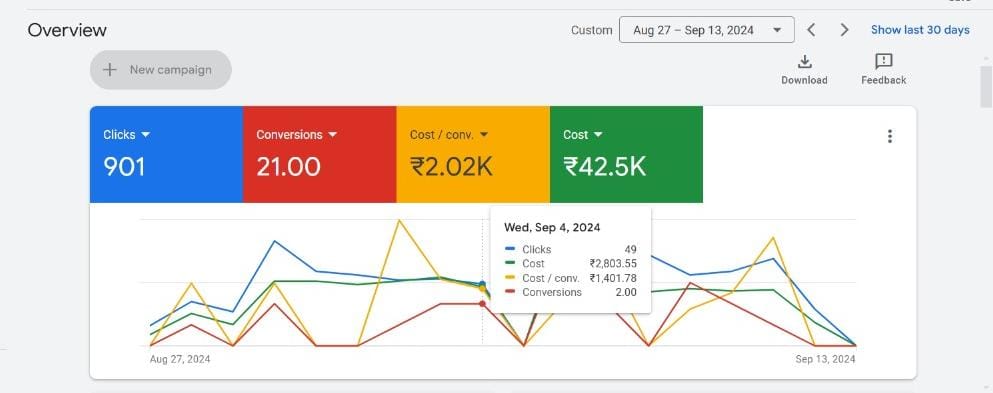Case Study: Ads Campaign Performance Mumbai
Mumbai

Overview:
A digital advertising campaign aimed at generating conversions had the following results:
- Clicks: 901
- Conversions: 21
- Cost per Conversion (CPC): ₹2,020
- Total Amount Spent: ₹42,000
Key Insights:
Conversion Rate:
The conversion rate can be calculated as:
conversion Rate=(ClicksConversions)×100=(90121)×100=2.33% A conversion rate of 2.33% is fairly good, particularly for e-commerce or lead generation campaigns, where conversion rates typically vary between 1-3%. This suggests the campaign is effective in turning clicks into conversions.
Cost Per Conversion (CPC):
The cost per conversion is ₹2,020. This is a reasonable cost depending on the industry and the value of each conversion. If each conversion generates more revenue than the cost per conversion, this campaign would be considered profitable.Total Spend Efficiency:
The campaign spent ₹42,000 to generate 21 conversions. The cost per conversion of ₹2,020 suggests that each sale or lead is costing the business a reasonable amount compared to the total ad spend.- If each conversion has a high lifetime value (LTV) or high average order value (AOV), this spend could be justified.
- However, if the LTV is low, the campaign might need optimization to improve the return on ad spend (ROAS).
Campaign Optimization Suggestions:
Improving Conversion Rate:
While the conversion rate is decent, optimizing the landing page or enhancing the user experience can potentially increase this number. For example, simplifying the checkout process or providing more compelling call-to-action elements can help.Ad Targeting:
The current targeting seems to be reaching an audience that is relatively likely to convert. Further refinement of the targeting (e.g., interest-based targeting, lookalike audiences) can help bring more relevant users, potentially improving conversions further.Cost Optimization:
The cost per conversion is fairly low, but exploring ways to reduce costs, such as optimizing bids or increasing the quality score of ads (through better ad relevance and engagement), could reduce the overall spend and increase profitability.
Conclusion:
The campaign is performing well, with a strong conversion rate and a reasonable cost per conversion. Further refinements in targeting, ad creatives, and landing page optimization could lead to even more conversions while maintaining or reducing costs. If each conversion is valuable to the business, this campaign would likely be considered a success.
